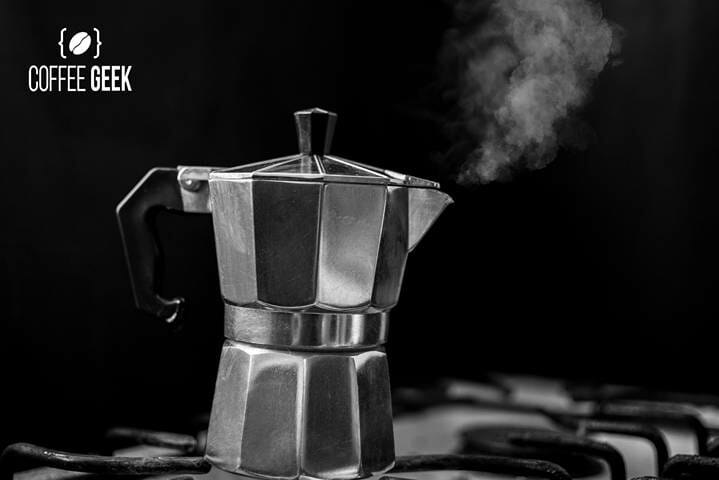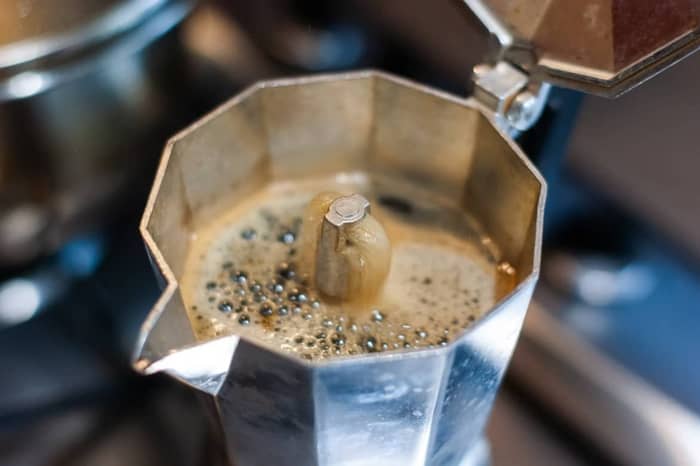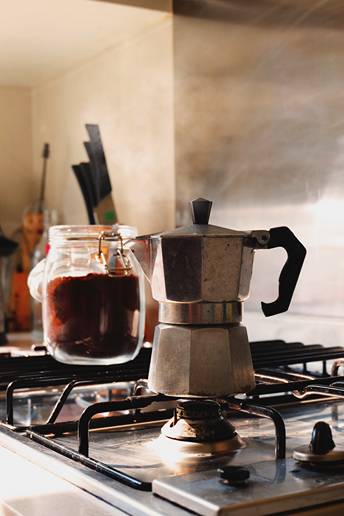If you cook, you must have been worried about your cooking pots, especially the pressure cooker, potentially exploding before.
Do you know what other item around the house that’s also tightly sealed and carries water being heated to a high temperature? BOOM! Your coffee pot!
In this article, we’ll drop the bomb on how your Moka Pot may potentially explode and 6 safety measures to keep your Moka Pots safe and sound.
Can A Coffee Maker Explode?
Not trying to add more anxiety to my caffeinated fellow coffee drinkers but the answer is: Yes, it can explode, especially if pressurized.
And what comes to mind when you think of pressure and coffee makers? Most will think of espresso machines. But today, we’ll discuss another type of espresso machine that works on an open fire instead.
Can Stovetop Espresso Makers Explode?
Yes, like your pressure cooker and espresso machine, your stovetop espresso maker AKA Moka Pot is also at risk of exploding due to its operating mechanism and your cleaning habit.
I will give you all the dirty details on it in the next section.
What Causes A Coffee Pot To Explode?
The short answer involves the following scenarios:
- Clogging the safety valve with ground coffee beans or limescale buildup;
- Overfilling the Moka Pot;
- Tamping the ground beans;
- Grind beans too finely;
- Brewing coffee at a heat too high.
And, below is the long answer for those who want to learn about all of the nooks and crannies:
How Does the Moka Pot Work?
To produce espresso-style coffee at home, Moka Pot is constructed so that steam pressure can be generated during the process to make the final brew more concentrated and stronger.
Here’s how it works:
The water in the bottom chamber – the boiler – is heated, which causes steam pressure to build up and push the hot water through the coffee grounds in the second chamber – the filter basket.
There’s a rubber gasket in place to make sure that the whole unit is tightly sealed for proper pressure building during the brewing process.
Eventually, the extracted coffee is pushed into the top chamber – the collecting chamber, ready to be served.
Moka Pot Explosion Explained
Since the process takes pressure, there’s always a risk of explosion.
To alleviate this risk, the Moka Pot is designed to come with a safety valve that’s supposed to release excess steam when there’s too much pressure.
You can rely on the release valve to keep you safe, but only the majority of the time.
There’s a small chance it may not work properly and blow up on you (possibly violently) due to clogging issues if you don’t regularly clean the Moka Pot inside-out.
So, what can the safety valve possibly get clogged with?
Coffee grounds can fall into this, get stuck, and cause blockage, which compromises the function of the safety valve.
So you need to clean the Moka Pot thoroughly after each coffee brewing session.
And, as with most coffee brewing devices, the Moka Pot also needs to be descaled once in a while to get rid of limescale buildup from water running in the brewer.
Keep in mind that using hard water means you need to descale the Moka Pot more often.
How come? This buildup of limescale will not only affect the flavor of your coffee but also clog the safety valve.
Other than being clogged, the pressure valve may also not function properly if you fill the Moka Pot with so much water that it covers the valve. It won’t be able to release pressure when necessary.
Even when the pressure valve can work properly, there are certain practices of making coffee that may also set off the “Moka Pot bomb”.
If you tamp the ground coffee in the Moka Pot, it may make it difficult for the water to push through the filter basket and make it to the collection chamber.
This means excess pressure will build up to a dangerous level that we all try to avoid.
The same scenario can also happen if the grind size is too fine. Remember to grind coarser than your typical espresso machine brew. Medium-fine should do.
More information can be found on the best grinds sizes in my Coffee Grind Chart.
Aside from that, brewing Moka Pot coffee on high heat is also a bad idea. Too much pressure will be generated too quickly and it may not be released in time through the pressure valve.
I recommend using either medium heat or medium-low heat for the perfect cup of coffee.
How Often Do Moka Pots Explode?
Luckily, it happens very rarely. Think once in a million brews. And they don’t happen randomly either. Only under the circumstances I stated above.
So you can rest assured that Moka Pots are perfectly safe as long as you take all of the precautions, which I will go into detail about later.
Can Coffee Percolators Explode?
A coffee percolator is another type of stove-top coffee-making device. It’s also essentially a pot but it makes coffee in a completely different way from the Moka Pots.
There’s a water chamber at the bottom and a perforated upper chamber that carries ground whole beans.
There’s also a small vertical tube running from the bottom chamber to the top of the percolator.
To brew a cup of percolator coffee, water in the lower vessel is heated and brought to a boil, which produces bubbles that will push the water up the vertical connecting tube.
This hot water will exit the other end of the tube and flow over the perforated lid of the coffee basket. The extracted coffee then falls back to the bottom, rinse, and repeat.
The brew cycle involves cycling the boiling brew through the grounds multiple times until the optimal coffee strength is reached.
So, are coffee percolators safe? Generally more so than your Moka Pots. The water continuously moves during the brew cycle so the buildup of steam pressure inside is less intense than Moka Pots.
How To Prevent Your Moka Pot Exploding – 6 Tips
Back to the Moka Pots. Here are what you can do to minimize the risk as much as possible:
- Get a quality Moka Pot that works properly, especially the pressure valve. Our recommendation is the Bialetti Moka Pot, which is manufactured by the company that invented it. You can also see my other Moka Pot Recommendations here.
- Keep an eye on your Moka Pot when it’s on an open fire, which should be applied to everything, to begin with.
- Get the grind size right and don’t tamp it.
- Only fill water a bit below the pressure valve.
- Use medium-low or medium heat only.
- Clean and descale it regularly.
You can navigate through the first 5 points yourself, so I’ll only provide instructions for number 6.
How Often Should You Clean Moka Pot?
Like with any coffee-making device, you should give it a good rinse after each use and a descaling session once in a while (Every few months should be fine. Do it more often if you live in an area using hard water.)
Are You Supposed To Clean A Moka Pot?
Some choose to not clean the device at all as the built-up residue becomes a “special barrier” that can elevate their coffee experience and it prevents unfavorable flavor transfer from the metal material.
But I personally advocate cleaning to avoid getting explosive coffee before even drinking it, if you know what I mean. The Bialetti brand itself is also on my team.
You can choose to clean it the easy way (habitually) or the hard way (when the Moka pot explodes), but your health can also be at risk if you neglect cleaning and turn the device into a dangerous ticking time bomb.
What you do need to keep in mind is you’re not supposed to clean the Moka Pot using detergent, especially on the aluminum models as it can taint the material and the coffee.
If you must, a mild detergent can be used on stainless steel models.
Also, avoid using abrasive objects to scrub if you don’t want any discoloration or damages to the surface of the device.
Stay away from dishwashers at all costs as well to prevent the loss of the inner coating.
How To Clean The Moka Pot Coffee Maker
So, what’s the right way to approach this? After the Moka Pot’s cooled down, dumping the old grounds, disassembling it, and giving it a simple rinse under warm water or cold water should suffice.
Take a few minutes and make sure no coffee grounds are still stuck anywhere, especially the filter basket.
All parts have to be completely dry before you reassemble and put away to not risk getting rust.
But if it does end up happening, you can use a non-abrasive dish brush to gently scrub the stains off in a mixture of white vinegar and warm water.
How Do You Deep Clean A Moka Pot?
For descaling, prepare a tablespoon (14.4 g) of vinegar and a tablespoon (14.4 g) of lemon juice and follow these steps:
- Fill the Moka Pot with water until the water level reaches just below the coffee filter basket.
- Add the vinegar and lemon juice you’ve prepared and mix it with the water.
- Let the mixture sit for around 3 – 4 hours.
- Afterward, discard some of it so that the liquid level is now below the safety valve.
- Run a normal brew cycle like you’re making a cup of Joe.
- When the Moka Pot’s cooled down, give it a rinse like how you do daily maintenance. You can also run a couple more brew cycles with just water to get rid of the smell and taste of the acids completely. Make sure they’re completely dry
Final Thoughts on Avoiding a Moka Pot Explosion
Follow all of our precautions and keep the Moka Pot clean and you can keep enjoying your Moka brew for a long time with no accidents. Stay safe and enjoy your delicious cup of Moka Pot!










